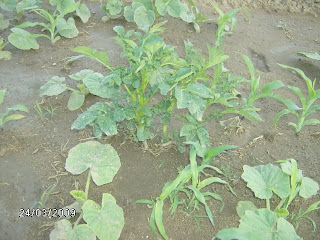I have run into a couple internet discussions that questioned the wisdom of using amaranth for chicken feed. Someone had mentioned that he found
one study that questioned the use of amaranth for chickens, because of of anti-nutritional factors (tannins, trypsin inhibitors, lectins, and saponins) that can actually lead to weight loss or sickness in chickens.
However, after having researched a number of scientific papers on the subject, it seems those negative results only occurred when over-feeding amaranth, above 20% of total feed, to very young chickens. When used as a reasonable portion of a balanced mix, amaranth has been shown to have a number of beneficial effects.
For example, one
study concluded:
It follows from the results of our work, that amaranth has a high nutrient value, low toxicity and makes an essential positive influence on productivity, integrity and physiological state of egg-laying hens of practically all age groups, without the increase of both cost and consumption of forages. Such effect of amaranth is exclusevely the result of normalization of metabolic processes and intensification of functional activity of basic organism systems. The positive effects, which were revealed by us, are related, on the one hand, to the high content of irreplaceable amino acids in amaranth, and on the other hand, to the unique vitamin, lipid and mineral composition of amaranth.
A
second study found: The suitability of amaranth grain or green parts for animal diets has been tested in trials on rats, lambs, rabbits, ruminants, pigs and broiler chickens.
In most of the trials, no negative effects on feed intake, feed conversion and live weight gains were recorded. Our results showed that
amaranth can fully replacemeat-and-bone meals in the diets for broiler chickens.
A
further study concluded:
High content of crude protein, favourable composition of amino acids and fibre of raw amaranth grain and high coefficients of apparent digestibilityof nutrients in a diet with 10% amaranth grain
predetermine raw amaranth grain to be a suitable supplement of conventional feeds in feed mixtures for broiler chickens.
The original
study above points out that even if young chickens who are overfed amarath have slight problems, full grown chickens don't have any problem with it: "results from a trial conducted during one stage of growth need not reflect the response at some other stage due to the systematic changes that took place as the bird aged. The improved performance of older birds on amaranth diets in the current study indicated that the grain might be more suitable in broiler finisher diets."
The study concluded that the anti-nutrative factors of raw grain amaranth were not significant: "Utilisation of the grain improved with age of the birds demonstrating that
raw grain amaranth would be more suitable as an ingredient for broiler finisher diets. Histopathological changes of the internal organs were generally moderate and could not be attributed to the feeding of amaranth."
The positive benefits of amaranth on chicken diets have been well-established, even
finding that amaranth can replace protein supplements:
Nutrient digestibility of feed mixtures with 10% crude, heat treated amaranth grain or of amaranth-free diet was studied in balance trials on male broiler chickens. Higher coefficients of nutrient digestibility (crude protein,ether extract, NDF, ADF, and gross energy) were recorded in the diet with crude amaranth grain compared to amaranth-free diet. Sensory indicators of meat of chicken broilers fed diets supplemented with 10% amaranth (crude or heat treated amaranth grain and dried biomass) were examined.
Meat samples from chickens fed amaranth in the diet showed better in all sensory indicators under testing (taste,tenderness, texture, colour) compared to the diet containing fish meal.
No negative effects of diets with amaranth on the above indicators were observed. Higher content of fibre in dry amaranth exerted no effect on the studied indicators.
Similarly, other studies did not find differences in live weights of broiler chickens fed diets with amaranth both heat treated and untreated, compared to the control.
Experimental groups of chickens fed amaranth containing diets gave results that were comparable in all performance characteristics with the control group fed animal protein.


















